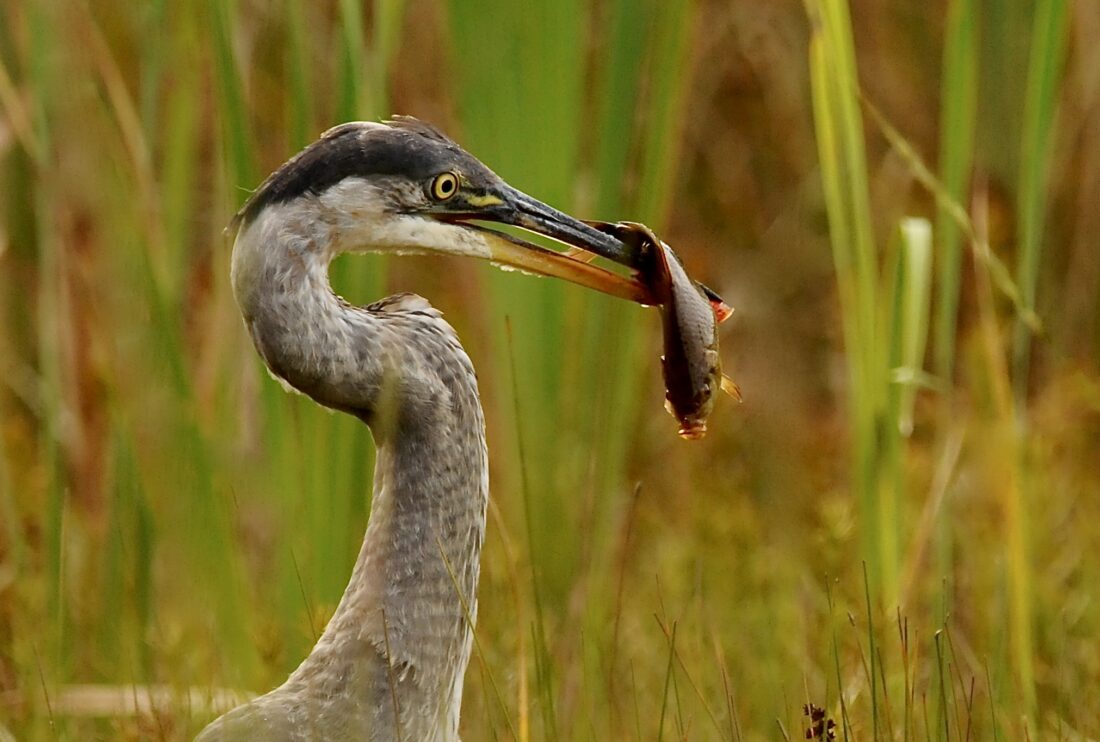What’s Flying: Apps can help ID what bird is singing

A great blue heron is shown with a brown bullhead in its beak. (Scot Stewart photo)
“You must hear the birds song without attempting to render it into nouns and verbs.” — Ralph Waldo Emerson
Summertime is the best time to grab a comfy chair and a glass of lemonade or a really cold slice of watermelon and sit on the porch for a while and watch the world go by. With a full crop of leaves on trees in mid-summer it can be really difficult to find a singing bird. With a little luck and a bare branch, a quick glimpse might be possible.
More often than not, the bird, singing and foraging, moves on to another tree and is gone.
It is however, getting a bit easier to find out what is sing in your neighborhood.
Over the past couple of years, a number of cell phone apps have become available to record and identify bird songs. Four of the most popular ones are Merlin, Song Sleuth, Chirp-o-matic and BirdNET. Each has a unique feature or two to set it apart but all work in a similar way. Cornell’s “Merlin” has become a popular on in the U.P. It does not require internet connections, records the bird songs heard, and as each bird is recognized will print its name below the sonogram, a pictorial scrolling, it creates.
As the bird sings it is highlighted on the list. It does occasionally make incorrect identifications from short bursts of sound or songs resembling calls birds, especially one not found in the area.
The other three do require internet connections, but have slightly more accurate ID’s. They also have some varying degrees of controls with specific ID’s allowing the user to start listening, then record a song, highlight the portion of the rolling sonogram, and have the app identify the bird.
For the older crowd, have one of the grandkids add it to the phone and presto, by turning it on, it will record the surrounding sounds, including some bird songs too faint for some ears to hear. It is quite exciting to turn on an app, listen to the sounds, and get a report of the birds singing in an area, and know there are probably more birds singing there than a birder realizes.
Shorebird watching continues to be spotty but interesting at all the favored sites. On the Lower Harbor breakwall a single semipalmated sandpiper was seen last Monday. Also present along the breakwall were two batches of mallard ducklings. On set had two very small young ones, but the other set had eight very active young swimming, then resting and preening on a low rock on the inside of the breakwall. What turned out to be most interesting was the interaction between the two families. As the larger group preened on the rock the approaching female, with her two smaller young charged up and pushed the hen with her eight off the rock, and then took their place.
At Whitefish Point north of Paradise a smattering of different plovers and sandpipers has been seen. On Tuesday piping plovers, killdeer, lesser yellowlegs, least and spotted sandpipers were seen during a four-hour watch on the beach. While some of these migrants just fly by, many do stop to rest and forage along the point’s long strips of wetlands. It is an expansive area. The combination of time and place make it impossible to catch sight of all the birds each day so there are more undoubtedly passing by getting missed. During the spring and fall counts for hawks and waterbirds, even official count data is kept for a specific period about eight hours each day and don’t “count them all.”
The AuTrain River mouth continues to provide daily surprises too. On Wednesday sanderlings and a spotted sandpiper were on the beach, but even better, a rare-to-the-area red-throated loon was seen off shore. They are more commonly seen during migration at Whitefish Point, but are generally flybys.
A central U.P. swimmer is quite rare.
For those watching from their porches, there has been plenty too. A sextet of blue jays has continued to entertain birders on the east side of Marquette with their begging, aerobatics and acrobatics.
They have had to contend with competition from common grackles, starlings and a hairy woodpecker at the suet feeder.
On the Dead River a birder has been watching great blue herons feeding in the shallows, using its feet to stir up invertebrates on the bottom. Great blue herons diets include a wide variety of aquatic animals like insects, frogs and tadpoles and fish. They are also capable of catching larger prey.
One was seen several years ago wandering into the woods near one of the ponds in Marquette’s Park Cemetery and catching a chipmunk. It walked back to the water’s edge dunked it and had a surprise slider for lunch, swallowing it whole!
In Quinnesec a birder has been listening to an array of songsters including goldfinches, a second brood of chickadees, and calls of a young great horned owl and a set of noisy Cooper’s hawk fledglings. The owlet had been most vocal after dark but had been chatting early one dawn morning.
The Cooper’s hawks are a bit different. They usually let the neighborhood know they are present, somewhat ironic because they do hunt other birds. But early on the mother may leave a fresh meal on a deck railing or other spot for the fledglings to share providing an amazing show for a porch sitter.
EDITOR’S NOTE: Scot Stewart is a teacher at Bothwell Middle School in Marquette and a freelance photographer.


